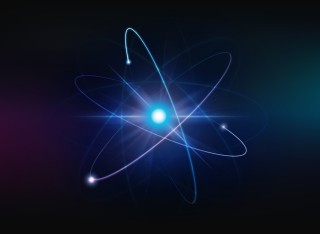
Jacob Heery
Academic and research departments
Publications
Since the nuclear interaction is, to first order, isospin independent, simple relationships can be derived for E2 strengths across isobaric analog states within an isobaric triplet. At the same time, there is a well-known relationship between the 2+ excitation energy and the B(E 2; 2+ -> 0+) transition strength in deformed even-even nuclei. Here, we highlight a tension between these two trends in the A = 78 isobaric triplet. Recent level-energy determinations indicate that the proton-rich member of the triplet, 78Zr, is strongly deformed while recent lifetime measurements in 78Sr and 78Y, as extrapolated into 78Zr, would imply that 78Zr is weakly deformed. Here, we explore the implications of this apparent contradiction and explore potential solutions.
The region of N Z 40 has long been associated with strongly deformed nuclear configurations. The presence of this strong deformation was recently confirmed through lifetime measurements in N Z Sr and Zr nuclei. Theoretically, however, these nuclei present a challenge due to the vast valence space required to incorporate all necessary orbitals. Recent state-of-the-art predictions indicate a near axial prolate deformation for N = Z and N = Z + 2 nuclei between N = Z = 36 and N = Z = 40. In this work we investigate the shores of this island of deformation through a sub-barrier Coulomb excitation study of the N = Z +4 nucleus, 80Sr. Extracting a spectroscopic quadrupole moment of Qs(2+1 ) = 0.5+0.8-0.9 eb, we find that 80Sr is inconsistent with significant axial prolate deformation with a significance of 1.5 sigma. This result, albeit with a large uncertainty, indicates that the predicted region of strong prolate deformation around N = Z = 40 is tightly constrained to the quartet of nuclei: 76,78Sr and 78,80Zr.
Lead-208 is the heaviest known doubly magic nucleus and its structure is therefore of special interest. Despite this magicity, which acts to provide a strong restorative force toward sphericity, it is known to exhibit both strong octupole correlations and some of the strongest quadrupole collectivity observed in doubly magic systems. In this Letter, we employ state-of-the-art experimental equipment to conclusively demonstrate, through four Coulomb-excitation measurements, the presence of a large, negative, spectroscopic quadrupole moment for both the vibrational octupole 3 1 − and quadrupole 2 1 + state, indicative of a preference for prolate deformation of the states. The observed quadrupole moment is discussed in the context of the expected splitting of the 3 − ⊗ 3 − two-phonon states, due to the coupling of the quadrupole and octupole motion. These results are compared with theoretical values from three different methods, which are unable to reproduce both the sign and magnitude of this deformation. Thus, in spite of its well-studied nature, Pb 208 remains a puzzle for our understanding of nuclear structure.
The radionuclide 152Tb, decaying by β+ emission and electron capture to 152Gd with T1/2= 17.8784(95) h, has been shown in its first-in-human use to be suitable for positron emission tomography (PET) imaging. As a member of the terbium theragnostic quartet, this radionuclide has potential applications in personalised cancer treatments. Sources of 152Tb were produced by proton-induced spallation of a tantalum target followed by on-line mass separation at CERN-ISOLDE. The sources were delivered to ILL Grenoble, where gamma–gamma coincidence spectroscopy of excited states populated in 152Gd following the decay was carried out using the Fission Product Prompt γ-ray Spectrometer (FIPPS). Preliminary analysis has resulted in the identification of multiple previously unreported excited states in 152Gd, thirteen of which are reported here at excitation energies up to 3746 keV. Angular correlation analysis has been used to provide initial spin and parity assignments to excited states. The result of the completed spectroscopy will be a revised gamma-ray and β+ dose to patients compared to the current expected values.
The neutron -rich strontium, zirconium, and molybdenum nuclei have been observed to undergo a dramatic evolution, becoming strongly deformed around N = 60, sometimes interpreted as a quantum phase transition between "normal" and intruder configurations. Key to understanding this evolution is to understand the configurations in isolation, in regions where interference can be neglected. A deformed coexisting configuration is inferred from the presence of a 0 2 state which decreases in excitation energy with increasing neutron number, becoming the first -excited state at 98Mo. We present here the results of a low -energy Coulomb -excitation measurement of the nucleus 96Mo, extracting B(E2) values and quadrupole moments. It is found that, while the B(E2) values agree with those found in the literature, there is a significant disagreement with literature spectroscopic quadrupole moments. The results are compared with shell -model calculations using a 88Sr core with good agreement found, likely indicating that intruder structures do not significantly impact the ground -state structure, in contrast with the heavier molybdenum isotopes.
Lifetime measurements in Pt-178 with excited states de-exciting through gamma-ray transitions and internal electron conversions have been performed. Ionic charges were selected by the in-flight mass separatorMARAand measured at the focal plane in coincidence with the 4(1)(+) -> 2(1)(+) 257 keV gamma-ray transition detected using the JUROGAM 3 spectrometer. The resulting charge-state distributions were analysed using the differential decay curve method (DDCM) framework to obtain a lifetime value of 430(20) ps for the 2(1)(+) state. This work builds on a method that combines the charge plunger technique with the DDCM analysis. As an alternative analysis, ions were selected in coincidence with the Pt-178 alpha decay (E-alpha = 5.458(5) MeV) at the focal plane. Lifetime informationwas obtained by fitting a two-state Bateman equation to the decay curve with the lifetime of individual states defined by a single quadrupolemoment. This yielded a lifetime value of 430(50) ps for the 2(1)(+) state, and 54(6) ps for the 4(1)(+) state. An analysis method based around the Bateman equation will become especially important when using the charge plunger method for the cases where utilising coincidences between prompt gamma rays and recoils is not feasible.
